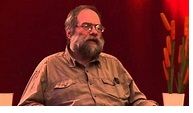
Sunthar Visuvalingam
CHICAGO: Among the handful of white Europeans speaking at the World Hindu Congress 2018 to be held here from September 7 to 9 is independent Belgian scholar Koenraad Elst, PhD. He is scheduled to speak on September 8 on “Implications of mis-portrayal of Hindus on Bharat’s policies and destiny.”
Elst has a track record of publicly critiquing Western Indologists for theoretical stances derived more from collective prejudice than incontrovertible evidence. The following is an interview with the respected scholar:
• How did you get exposed to Indian culture and whence this abiding sympathy for Hinduism?
I’m from a provincial Belgian Flemish background but my father, though a staunch Catholic, was a committed Hatha Yoga practitioner.When I began searching for my own truth, I took up Chinese and Indian philology and history. Later I was in Varanasi researching Indian philosophy. My meeting in 1989 with historian and publisher Sita Ram Goel catalyzed this radically new chapter in my life.
• What are the key Indological controversies that your publications have addressed?
This was also when I was exposed to my first controversy: Ayodhya. The consensus had been of a Hindu temple forcibly replaced by Babri Masjid. But “eminent historians” suddenly turned that consensus into a “Hindu fascist concoction” such that reasonable settlement became impossible. In the polarization that followed, the whole of Western academe fell in line with the eminences, which served as an argument of authority for their brand-new orthodoxy.
That controversy forced me to study the theology of Islamic iconoclasm. My first major publication, in Dutch, was on the controversy aboutThe Satanic Verses, Salman Rushdie’s novel about the beginnings of Islam, especially its turn against the three goddesses of pagan Arabia and thus against polytheism. It is little-known that the Rushdie affair had started as aramification of the Ayodhya conflict.
In the 1980s I still espoused the Aryan invasion theory, not knowing it was already being questioned by KD Sethna through his research on cotton, absent in Rig-Veda but evidenced in the Harappan archaeological record. Reading his book in 1990 against the linguistic background, I realized there was no real proof for the established view that the Indo-Aryans came from Central Asia. More evidence has since accumulated for India itself as homeland of the Indo-European (“Aryan”) language family.
Mahatma Gandhi was a complex figure and some of the good said about him is still true. But the negative side has been pushed under the carpet because, by being murdered, he became a saint, never to be questioned. I thought the time had come to restore the balance. Assassin Nathuram Godse had a case, and many of his contemporaries were on the same wave length, but it became unsayable.
• How has the Western academy received your counter-theses and treated you personally?
The Ayodhya controversy made me a pariah. That is why I really savored the news in 2003 that the foundations had been dug up and the pre-existence of the temple had become undeniable. A few “eminent historians” in Delhi still tried to sow doubts, but most understood that the game was up. Not that anyone has formally conceded, let alone apologized, but the sudden silence about the historical side of the affair is eloquent enough. In 2010, after the court verdict acknowledged the Hindu claim to the site, I received congratulations from one of the American professors hated by Hindus for a stance deemed sacrilegious. But that was about all.
I was nevertheless fortunate in an intellectual sense. Firstly, my stance opened the doors of the otherwise secretive Hindu movement, which allowed me to write a remarkable Ph.D. thesis about it, published as Decolonizing the Hindu Mind. Secondly, I was still around to witness the moment when the old consensus got vindicated and all the eminences had egg on their faces.
My article on The Satanic Verses was published in a Belgian Leftist journal, because in those days the European Left was still candidly secular, not in the Indian sense of “anti-Hindu.” A few years later, though, it became militantly pro-Islamic and therefore started treating me with hostility. In India, the power equation in academia has not changed, not even under the Vajpayee and Modi governments: so, both in the West and in India, I am persona non grata. Though Islam has lost my interest, I am still reduced to my positions on it. However, the torch has been taken over by ex-Muslims, who write in the same vein as me. No fatwa can stop it anymore, not from the Mullahs nor from “eminent historians.”
My pleas for the Out-of-India Theory likewise led to exclusion, but less grimly. Evidence in favor of OIT is accumulating, and the younger generation of scholars is acknowledging it as a contender. In Belgium, I have been re-accepted by Orientalists and Indo-Europeanists as one of them.
[To be continued]






